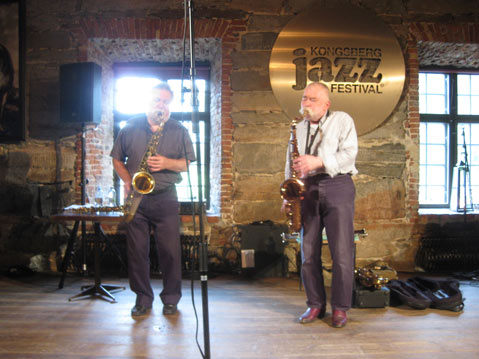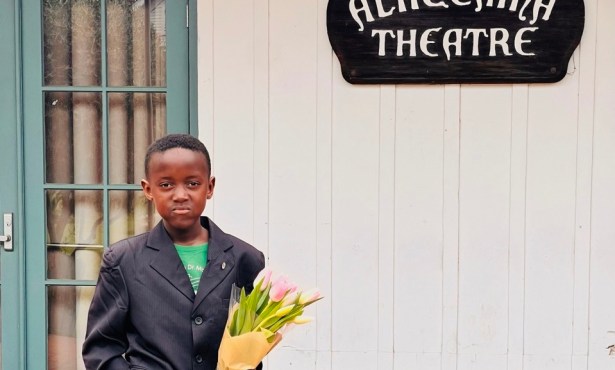Greetings from Kongsberg
Norway’s Jazz Festival Season Kicks Out the Jams

RIVERS RUNNING THROUGH IT: There is something special, visceral and maybe metaphor-powered about a city with a river running through it. We’re not talking about a pleasant, trickling, ambling sort of river off to the side of the city, but a large, raging water source slicing right down the rough middle of the city limits, marrying nature and human doings and reminding us of the Randy Newman lyric “I’m looking at the river, but I’m thinking of the sea.” For this purpose, we’re talking specifically about the city of Kongsberg, Norway—about two hours west of Oslo in a loveably woodsy forest region—where the forceful and awesome Numedalslågen river divides two sides of town, separated by a dramatic bridge which becomes a symbol and a passageway of very real and very poetic proportions.
For jazz fans and jazz festival followers, Kongsberg also represents something significant in the larger festival cosmos, as the second biggest of Norway’s impressive jazz festival scene, after the 51-year-old Molde festival in western Norway (going on next week), and the one most likely to host your favorite improvisers and free blowers. Last week’s edition was year number 47 (these Norwegian festivals just won’t quit, God bless them, and thanks to the culture-supportive government and, of course, the power of oil money). This festival brought to town such left-end notables at the German Peter Brötzmann, the British Barry Guy, and the proudly Norwegian/global drum sensation Paal Nilssen-Love, a true sensation in whatever musical context you care to mention.
ON THE POP SIDE: This is a smart festival, in more than one way. While the avant-garde aspect of the program is key to the programming’s aesthetic agenda, that facet is also wisely tucked into smaller, side street venues—down by the river, as it turns out. But there are other levels and layers of public interface that help secure money flow and the city’s active involvement, thereby appeasing different types of listeners. A more casual local contingent sees the festival as a ripe excuse to eat, drink and get extra-merry and tipsy at the outdoor stages, in the woozy encampment by the central Grand Hotel, and at the large outdoor “Tubaloon” stage area. This compound boasted the populist, groovular likes of potent Afrobeat star Seun Kuti & Egypt 80 (coming next season to Campbell Hall—mark your calendar) and blues chanteuse Shemekia Copeland—another talented offspring, Johnny Copeland’s daughter, on the heels of Fela Kuti’s son. On the final of four nights, the stage rattled nicely with a double-header rock summit: Norway’s hypnotically good hard rock/jam band Motorpsycho and America’s offbeat alt-prog-rocking favorite Primus.
ON THE JAZZ SIDE: Moving from the raucous to the reflective, next door to the Tubaloon is the beautiful and beatific old 18th century Kongsberg church, a stunning place to hear the right kind of music. Here, the duo of Brad Mehldau and Joshua Redman held forth, with Mehldau—one of the most compelling and evolving musicians in jazz at this moment—diving deep while his more safety-minded partner stayed in the realm of profound proficiency. The next day in church, Charles Lloyd (Santa Barbara’s own!) showed up with his particularly inspired current “New Quartet” (heard at the Lobero last year). It was an odd thing, though, going straight from the ferocious Brötzmann-Parker blowfest up to the Lloyd concert, which sounded extra-mellow and gauzy under the comparative circumstances. So goes the incidental and sometimes disorienting study-in-contrast phenom—and part of the charm—of this jazz festival addict’s experience.
Also in the church was the world music-y Marilyn Mazur Celestial Circle (featuring the wonderful Swedish vocalist Josefine Cronholm) closing the festival, at the bewitching hour of midnight on the final night. Meanwhile, the Kongsberg kino (movie theater/auditorium) hosted the likes of seasoned ECM-linked bassist-leader Arild Andersen’s group, with trumpeter Markus Stockhausen, Scottish saxist Tommy Smith and a stellar sub pianist, the Polish Marcin Wasilewski.
A rather surreal but moving event unfolded in a conference room-turned-press-conference room in the central hotel (a room with picture windows overlooking the mighty river, by the by). VIPs and press types had gathered, champagne at the ready, for the annual presentation of the DnB NOR award, Norway’s largest jazz prize—offered by DnB bank. Alas, the prize winner, the great midcareer trumpeter Arve Henriksen, was at the North Sea Jazz Festival and accepting yet another prize there, so had to appear in a not-inappropriately ethereal manifestation on a large screen via Skype. Voila, he was very much there in the room, while also somewhere else, a paradox also found in his music.
Henriksen, a humble, multi-faceted and fascinating artist who has been working diligently and artfully, and with his own distinctive, fluid trumpet voice, in his group Supersilent and in bands led by Christian Wallumrod and many others for years, has suddenly found himself in a deserved international spotlight of his own, particularly since the release of his debut for ECM, the entrancingly good Cartography, in cahoots with electro-conjurer Jan Bang. Although he modestly reported that winning the prize was “amazing and a little bit hard to understand,” Henriksen is, in a way, the current “new” star of the Norwegian jazz scene, and he will be working on a special project for next year’s Kongsberg festival.
ON TO MOLDE: Next week in Molde, in fact, Henriksen will be in the good company of his classic and hard-to-describe band Supersilent with special guest John Paul (Led Zep) Jones, who had heard the band at yet another unique Norwegian festival, Punkt, and wanted to get involved. It would appear that Norway is a kind of cultural-musical hot spot on the planet at the moment, not to mention being a beautiful, spacious and nature-filled place to visit (and one of the more expensive places, it should be noted: watch your kroners).
A DIFFERENT DRUMMER: For my money and ears, the star of this year’s show was Nilssen-Love, who played in the head-bangingly, head-clearingly powerful new Brötzmann trio (with electric bassist Massimo Pupillo rumbling below, and giving it a rock-jazz-free power) and as a sub drummer in the galvanic band Zu, your basic bass/drums/two baritone sax energy force (with mighty Swede Mats Gustafsson, also heard in Barry Guy’s New Orchestra, added to the sax mix). But the high point of was the leanest context, as Nilssen-Love demonstrated his unique gift in the challenging solo drum setting. Here, his range of intensities, color, gesture and invention could be most personally expressed, without bending to the terms of a band circumstance.
Walking out off that Saturday afternoon concert, the rain was coming down, the river was going full blast just across the street and all seemed right and raging with the world, for a minute. You take fleeting epiphanies when and where you can get ‘em.
Fringe Beat has gone cyber, facebooked and twittered (@FringeBeat), and myspaced and ?. Please join, if inclined.



